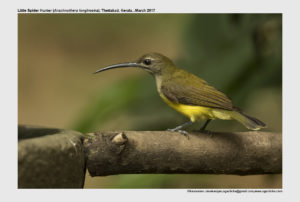Little Spiderhunter

Little Spiderhunter Arachnothera longirostra
Etymology:
- Arachnothera : Greek word arakhnes- spider; theras – hunter
- Longirostra : Latin word longus- long; rostris-billed
Vernacular Names: Mal: Tenkilimatan, Mar: Chota Kolikhau
Distribution in India: Resident of Easter Himalayan foothills, Hills of East and North East and South WestIndia.
Description: Size of 13·3–16 cm; wt. of male is 10·3–16·1 g, wt. of female is 8·8–14 g. The male of nominate race has very long, stout, gently decurved bill; plumage is olive above, crown feathers are dark-centred, side of head is grey, lores are white, short blackish submoustachial streak; upperwing-coverts are olive, remiges are dusky-brown with olive edges, tail is dark brown, fringed olive and narrowly tipped whitish; throat and breast are greyish-white, breast is tinged yellow, rest of underparts are bright yellow, whiter on undertail-coverts, pectoral tufts are orange; iris is brown to dark brown; bill is horn-brown, greyer on gonys and at base of lower mandible, black above and pale grey below; legs are black, blackish-grey or bluish-grey. The female is similar to male but smaller, has whiter throat, paler base of lower mandible, and lacks pectoral tufts. The juvenile is similar to female but browner, with bright olive fringes on wing feathers, and paler bill and feet.
Habitat: It is found in understorey of various types of forest, mangroves, regenerating secondary forest, disturbed and heavily logged forests, forest edge, also coastal vegetation, secondary growth, plantations, gardens and cultivation, particularly around plantains and gingers. It is found up to 2200m.
Food habits: It eats nectar, insects, and spiders. It forages singly and in pairs, mostly in lower levels of vegetation. It takes insects from spider webs, and from pools of water in vegetation. It pollinates and takes nectar from erect or pendulous inflorescences.
Breeding habits: They breed in Dec–Aug in South West India and May–Aug in Assam; Mar–Sept in Nepal, Jan in Thailand, Dec–May in Malay Peninsula, May–Jun and Aug in Sumatra, and in all months except Nov in Java. The nest is a compact cup, with semi-circular entrance hole on one side , constructed from leaf skeletons, soft grass and vegetable down neatly felted together, lined with fine grass, and attached by rim to underside of banana leaf by cobwebs or vegetable cotton passed through leaf and knotted on upper surface, or made from rootlets, dead leaves, plant fibres and cobwebs in tunnel created by the sewing-up of ginger and plantain leaves; placed under Khydia leaf, or in elephant grass, or under giant creeper or large dock leaf or on castor-oil plant .They lay a clutch of 2- 3 eggs. The nest is parasitized by Violet Cuckoo, Asian Emerald Cuckoo, Common Cuckoo Large Hawk-cuckoo and Hodgson’s Hawk-cuckoo.